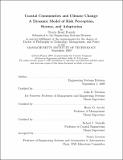| dc.contributor.advisor | John D. Sterman, Henry D. Jacoby and Robert J. Nicholls. | en_US |
| dc.contributor.author | Franck, Travis Read | en_US |
| dc.contributor.other | Massachusetts Institute of Technology. Engineering Systems Division. | en_US |
| dc.date.accessioned | 2010-05-25T19:19:55Z | |
| dc.date.available | 2010-05-25T19:19:55Z | |
| dc.date.copyright | 2009 | en_US |
| dc.date.issued | 2009 | en_US |
| dc.identifier.uri | http://hdl.handle.net/1721.1/54846 | |
| dc.description | Thesis (Ph. D.)--Massachusetts Institute of Technology, Engineering Systems Division, 2009. | en_US |
| dc.description | This electronic version was submitted by the student author. The certified thesis is available in the Institute Archives and Special Collections. | en_US |
| dc.description | Cataloged from student submitted PDF version of thesis. | en_US |
| dc.description | Includes bibliographical references (p. 303-311). | en_US |
| dc.description.abstract | Climate change impacts, including sea-level rise and changes in tropical storm frequency and intensity, will pose signicant challenges to city planners and coastal zone managers trying to make wise investment and protection decisions. Meanwhile, policymakers are working to mitigate impacts by regulating greenhouse gas emissions. To design effective policies, policymakers need more accurate information than is currently available to understand how coastal communities will be affected by climate change. My research aims to improve coastal impact and adaptation assessments, which inform climate and adaptation policies. I relax previous assumptions of probabilistic annual storm damage and rational economic expectations-variables in previous studies that are suspect, given the stochastic nature of storm events and the real-world behavior of people. I develop a dynamic stochastic adaptation model that includes explicit storm events and boundedly rational storm perception. I also include endogenous economic growth, population growth, public adaptation measures, and relative sea-level rise. The frequency and intensity of stochastic storm events can change a region's long- term economic growth pattern and introduce the possibility of community decline. Previous studies using likely annual storm damage are unable to show this result. Additionally, I consider three decision makers (coastal managers, infrastructure investors, and residents) who differ regarding their perception of storm risk. The decision makers' perception of risk varies depending on their rationality assumptions. | en_US |
| dc.description.abstract | (cont.) Boundedly rational investors and residents perceive storm risk to be higher immediately after a storm event, which can drive down investment, decrease economic 3 growth, and increase economic recovery time, proving that previous studies provide overly optimistic economic predictions. Rationality assumptions are shown to change economic growth and recovery time estimates. Including stochastic storms and variable rationality assumptions will improve adaptation research and, therefore, coastal adaptation and climate change policies. | en_US |
| dc.description.statementofresponsibility | by Travis Read Franck. | en_US |
| dc.format.extent | 422 p. | en_US |
| dc.language.iso | eng | en_US |
| dc.publisher | Massachusetts Institute of Technology | en_US |
| dc.rights | M.I.T. theses are protected by
copyright. They may be viewed from this source for any purpose, but
reproduction or distribution in any format is prohibited without written
permission. See provided URL for inquiries about permission. | en_US |
| dc.rights.uri | http://dspace.mit.edu/handle/1721.1/7582 | en_US |
| dc.subject | Engineering Systems Division. | en_US |
| dc.title | Coastal communities and climate change : a dynamic model of risk perception, storms, and adaptation | en_US |
| dc.type | Thesis | en_US |
| dc.description.degree | Ph.D. | en_US |
| dc.contributor.department | Massachusetts Institute of Technology. Engineering Systems Division | |
| dc.identifier.oclc | 608089634 | en_US |
